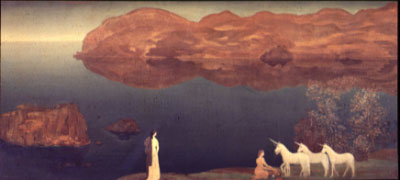 |
Arthur B. Davies |
| Home | Ashcan School | Back to thesis (page 6) | |
 |
Arthur B. Davies |
| Home | Ashcan School | Back to thesis (page 6) | |
 |
Unicorns, 1906. oil on canvas, 18 1/4 x 40 1/4, Metropolitan Museum of Art, New York City |
The following information was copied from pages 432 in:
Craven, Wayne. American Art: History and Culture. New York: Abrams, 1994.
| One of the main figures in the New York City art world of
this ear was Arthur B. Davies (1862-1928). Although he exhibited
in The Eight show of 1908, his work was very different from that of the
realist members of the group.
After studying at the Chicago Art Institute, Davies moved to New York City in 1896, where he earned a living as a magazine illustrator. In that same year, William Macbeth offered him his first oneperson show at his gallery. Davies's propensity to paint dreamlike visions was already present in his early works, and critics linked them to the visionary imagery of Ryder and Blakelock. The critics also used such words as "innocent," "childlike," and "naive" to describe his work. The department store magnate Benjamin Altman took an interest in Davies, and subsidized a trip to Europe in order for him to study. There, Davies discovered a rich variety of inspiration, ranging from the great Venetian Renaissance painter Giorgione to the nineteenth-century French artist Puvis de Chavannes, and from the color used by Delacroix to the Romantic mysticism of Arnold Bocklin. Davies's work has been associated with the fantasy imagery of the Symbolist movement, especially in its dreamlike aspects, and some of his early pictures bear a similarity to the dream-visions of Odilon Redon. Although none of these influences has any connection with the seamy street scenes of the Henri--Sloan--Luks group, soon after his return to New York, Davies joined with these men and their friends in their rebellion against the National Academy. Davies's work during the opening years of the new century is exemplified in Unicorns--a gentle idyll set amid a floating dream-world that praises the innocence of maidenhood. Davies's work characteristically dealt with similar themes of poetic visions, far removed from the realities of urban life. When Robert Henri began to mobilize his forces in rebellion against the National Academy, Davies entered the fray and was instrumental in getting MacBeth's gallery for the 1908 exhibition of The Eight. John Sloan recalled that most dealers would not touch such controversial art. Davies also showed his work with the Henri group and other artists in the 1910 Exhibition of Independent Artists, which was scheduled at the time as the National Academy's annual show. Gallerygoers turned out in great numbers to visit the Independents and stayed away by the hundreds from the Academy. The insurgents had won a decisive victory. The stodgy old Academy had to come around to admitting some of them, and to showing their work. |
|
Back to Top | Home | Ashcan School | Back to thesis (page 6) |
Armory Show Web Site
Linda M. Larson. All rights reserved.
Revised: 29 Nov 2000 14:30:28 -0500 .